i was feeling kind of hopeless as i made my way out of the university of calgary. how on earth was i going to find a handful of dinosaurs in a giant city like calgary? especially when they were trying to hide!
pulling me momentarily out of my depression, was a man that walked by me in the science building's lobby. it took my tiny brain a minute to click into who he was, but i thought he looked familiar...
then it hit me, and i sprinted after him...
 "doctor hildebrand?" i called, and fortunately for me i remembered right!
"doctor hildebrand?" i called, and fortunately for me i remembered right!
dr. alan hildebrand turned around and was slightly puzzled to see me (i assume more because he is not used to dinosaurs calling him down, rather then hearing his name) "yes," he said to confirm it was him. "how can i help you?"
i'd never met dr. hilderbrand before, but knew him by reputation and from his many appearances on science documentaries.
i quickly introduced myself, and he was kind enough to put up with my fanboy yammering for a couple of minutes.
why was i so in awe of meeting dr. hilderbrand you might ask?
well i shall answer that question... even if you didn't ask it!
in short he is one of "the dudes" when it comes to asteroid research...
 why his meteorite work is of interest to me in particular (not that asteroids aren't cool in their own right!) is that his most famous discovery related to space rocks was the one that (may) have wiped out the dinosaurs!
why his meteorite work is of interest to me in particular (not that asteroids aren't cool in their own right!) is that his most famous discovery related to space rocks was the one that (may) have wiped out the dinosaurs! you have probably heard this idea...
you have probably heard this idea...
a really big asteroid hit the earth 65 million years ago at the end of the cretaceous period (this impact in fact "caused" the end of the cretaceous as the extinction is what geologists used to define the periods end), and the damage its crashing into our planet was so powerful it devastated every known ecosystem of the time!

the asteroid gets lots of the blame, but in some ways it was the earth's "fault" things got so bad after the interstellar accident. the meteorite was going so fast and had so much energy that it exploded and vaporized when it hit the planet.
well this kicked a lot of things up into the air (and possibly higher then that!) ranging from dust to outright molten rock! that's right this was so big an impact that sky filled up with something very much like lava, which then rained down just like evaporated water normally does when it gets to heavy to stay in the air.
if the earth had been made of different stuff, this wouldn't have happened. so this is why i say the bad things that followed are as much due to do with the earth as the asteroid.

there was only one thing worse then raining lava (which no doubt did untold damage... which we find evidence of all over the world in rocks of this era), and was the smaller lighter dust and dirt that continued to float. after the heavier fiery stuff fell out of the sky (causing forest fires ALL over the world at the same time!!!), the cloud of dust lingered in the sky and blocked out all the light.
meaning there was no sun for plants to use in making food. if you get rid of plants the whole animal food chain falls apart!
this caused the final extinction of the dinosaurs (i say final, as the vast majority of dinosaurs species had gone extinct well before this event during our 160 million year existence, only the last few families still alive at this point were alive to be killed... which sounds weird i know, but is true!), and numerous other creatures of the time.
this whole sequence of events has pretty much been accepted by science. even people who don't know a lot about dinosaurs or palaeontology can tell you the rough story. however this wasn't always the case...
when this theory was first proposed by geologist walter alvarez and his father, super famous nobel prize winning physicist, luis alvarez it was hotly contested. one of the key problems they had in proving their theory, was where did the asteroid hit?

this is the part of the story where dr. hildebrand played a key role... though not at first.
a few years before the alvarez's proposed an asteroid impact 65 million years ago, in 1978 the crater site was indirectly discovered by geologist glen penfield. he recognized a number of anomalies in the local geography of the yucatán peninsula of southern mexico (i used to call yucatán the little alligator mouth at the bottom of north america...).
however due to an inability to get access to sites and better samples he was unable to work out what exactly he had stumbled across. penfield wrote up a paper about what he could only see as a cataclysmic event in the cretaceous, but suspected the final answer would be extraordinary...
many years later enter, then a grad student, alan hildebrand. he grew very interested in the theory of an asteroid impact and began trying to find the prehistoric crater as his grad project. unaware of glen penfield's work in mexico, hildebrand slowly began to close in on equatorial america as the most likely site. recognizing clues in haiti, hildebrand might have closed in on mexico by himself, but he then learned of glen penfield's findings.

hildebrand approached penfield, and the two resumed penfield's abandoned search from over a decade previous. it was a historic team up, and with hildebrand in america he could get access to the one thing penfield couldn't in mexico. old drill samples stored state side. analyzing these samples the two published on how they believed yucatán was the site of the meteorite's landing.
they would be proven correct. a later satellite survey from outer space would detect a still visible (underground buried mind you, but it was undistorted millions of years later and thus visible when you look through the rock with sensors) a nearly perfect circular crater.
so like many of the biggest discoveries, it took a lot of people to get to the truth. one of whom i was shaking the hand of here today! it was really cool to get to meet dr. hildebrand. sadly he didn't have time for a chat. i only really got to introduce myself.
it was really cool to get to meet dr. hildebrand. sadly he didn't have time for a chat. i only really got to introduce myself.
"well it was nice to meet you," dr. hildebrand said in conclusion. i thanked him for his time, and expected to be on my own way... then he caught me totally by surprise with another sentence. "hopefully i'll bump into you down in collections soon."
"what?" i asked in total confusion. then i thought i understood "oh no i don't work here at the university. they don't have an theropod 'lab rats'."
this seemed to make sense to dr. hildebrand. "that explains why i hadn't seen any of you guys down there before."
"guys?" i asked not following.
"your friends," dr. hildebrand offered, hoping i'd know what he was talking about. obviously my lack of following him came across. "all you theropods down in the geology collections."
did he just say what i think he did!?!
i begged dr. hildebrand to explain... i couldn't believe it, not only was he an asteroid guru, he may have just lead me right to the crate i so desperately was trying to find!
while going into the deep bowels of the uni's geology department's collections dr. hildebrand said he'd encountered a group of theropod dinosaurs in one of the more remote corridors of the basement. he figured they were just part of the palaeo departments dinosaur lab rat collection.
"were they coelurosaurs?" i asked.
"well i'm no expert," dr. hildebrand warned as he thought about it a second. "now that you mention it, if i had to go off my momentary observations, yes i would say they all were."
"thank you so much!!!" i said completely sincere to dr. hildebrand. "you have been a HUGE help! i have to go though."
thinking about now, i guess it was a little rude of my to run off on dr. hildebrand. it was for a good reason... hopefully i'll get to meet him again and explain my reasons...
however now i had a pack hunt on my claws...


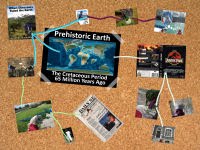


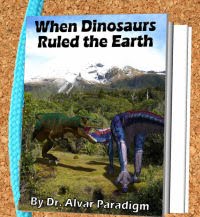


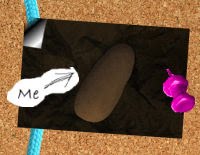





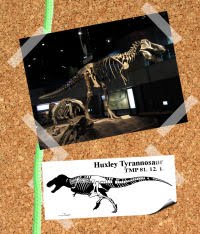








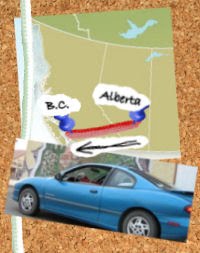









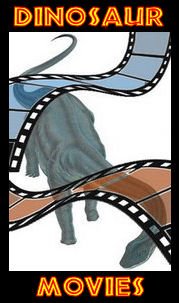






7 comments:
It be really great to meet such a key person in the study of the K/Pg extinction!
Not only that, you might just have a clue to tracking down the Pack!
It would be really cool, as Albertonykus said, to meet such a key expert in the K/Pg extinction! I would love to meet someone like him one of these days! :) And, I think we have found, not only the Pack, but what may be INSIDE the crate!! I have an idea and we may find out whether I'm right soon enough! :) So many questions will be answered SOON!! I'm so giddy with excitement and suspense! :D
About the Chicxulub Impact, I really am skeptical of it's role in the K/Pg extinction. I personally believe that there is more to it than one huge Armageddon. Read Fossil Fact #11 to know where I stand on this debate. Plus, there is a HUGE problem with a lot of thoughts on Extinction and the Environment, especially when they fail to Incorporate Complexity Theory (Formerly known as "Chaos Theory," by the late Heinz Pagels, and something I hope to do a post one at some point when I return!)
Raptor Lewis, you're right that some dinosaurs were already dying out before the impact. (Centrosaurine ceratopsians, for example. They all died right before the end. So did lots of hadrosaurs and theropods.) There certainly were other factors like the Deccan Traps around at the time. However, the meteor probably did lay the final blow at least to the dinosaurs that did make it to sixty-five million years ago. (The Hell Creek guys are the poster children for this.)
Dudes (albertonykus and raptor lewis)- waiting on mike for some sort of translation on this possible clue.
on the exact impact of the, well, impact...
raptor lewis, chaos theory is no doubt a key factor in evolution and extinction during "normal" periods of time, but it can NOT even remotely compete with an asteroid hitting the earth in being a driver of extinction.
first off the geologic evidence for an asteriod impact 65 million years is pretty much irrefutable.
the concentration of iridium found worldwide in the KT clay layer could not have come from anywhere but outerspace (it doesn't occur naturally on earth in any concentration). the shocked quartz show something incredibly powerful exploded (in fact more... there needs to be new word for bigger then exploding!).
so unless aliens came and nuked the earth (nuclear explosions being the only other thing we know of that can cause shocked quartz) it was an asteroid...
now an asteriod hitting the earth is not something we can even imagine. when you hear about something hitting something else, we instinctively think of this as possibly survivable or small scale. these are bodies bigger than an ecosystem squished into a ball hitting into each other!
this space rock exploded with a force comparable to 1-2 MILLION nuclear weapons when it hit the earth... seriously think about that. not hundreds, or thousands. millions of nuclear weapons exploding. a single nuke can just through the power of the explosion (forgetting the radiation which asteroids don't have) can destory everything around a city.
millions of them (or a single asteriod) would have released enough power and energy to wipe out everything around it on a continental scale! the KT space rock hit in the middle of the americas. meaning both most of north and south america would have taken the DIRECT brute of the explosion. meaning those two landmasses would have been instantly devastated, and driven to extinction. that alone would have quickly impacted the rest of the world (that alone the fact the explosion would have been followed by worldwide lava fallout... think about that, lava falling out of the sky EVERYWHERE!!!)
then lets remember this wasn't just the dinosaurs going extinct we're talking about. below the boundary we find all sorts of organisms both micro and macro, and then on top of the layer most of them are just gone!
this wasn't just some gradual interplay of complexity theory. everything i just listed (and we have found direct conclusive proof of) is your "huge Armageddon"... there is no single other explanation for every terrestial AND marine environemnt suffering critical extinctions at the exact same moment in geologic history.
so i flat out disagree with your take on the extinction event i'm afraid
Dudes (albertonykus and raptor lewis) again-
on the subject of dinosaurs being gradually driven to extinction before the KT... we're finding THIS was an examples of complexity theory...
there were major environmental changes going on in the last 5-10 million years of the cretaceous. the exact causes are debatable (where as the asteroid at the end is not debatable... whether it was one or more space rocks is the only question that we can't answer at moment).
rather then look at montana's hell creek and judith river, you should look at alberta's dinoasur record from the late cretaceous. alberta goes back 12-15 million years further back then montana and is a more continuious record.
now if you look at dinosaurs leading up to the KT in alberta yes there is a decrease in overall families (the lambeosaurs and centrosaurs disappear for example) however the remaining families increase the number of genuses and speices to fill the voids (the hadrosaurs and chasmosaurs). in other words big scale diversity decresased, but overall biodiversity remains the same
the one exception is 1-2 million years pre asteriod (the main hell's creek)... but there is debate on whether this was a global decline or just a north american one (specifically western NA). we only really have a stong fossil record from montana and moderate one from canada really. there is a growing opinion this was a local extinction due to the draining of the western interior seaway... so this is an open question, as there aren't any other strong end of cretaceous dinosaur assemblages to compare to elsewhere in the world. so we need to find more overall late cretaceous palaeo environments to answer this question...
now this would seem to paint a sad picture for the dinosaurs, but not when you think about our history earlier in the mesozoic. there were many times where whole saurian families were wiped out (prosauropods for example) but this then caused other families to suddenly branch into a diverse range of new subfamilies (the sauropods exploding into its rich range of families)...
so again the gradual overall extinction of the dinosaurs argument just doesn't hold up. all we're seeing is a usual cycle of extinction and responsive evolution in the late cretaceous... only this particular instance of the cycle was interupted by a HUGE space rock causing an unimaginable amount of damage!
I think you just hit the nail on the head, Traum. That was a very thorough analysis, and one I completely concur with. Not bad for a dinosaur with a peanut-sized brain! You're a lot smarter, or at least more knowledgeable, than you give yourself credit for.
I never said it wasn´t irrefutable. I was merely saying that I'm not going to hop and down like a fool saying anything for certain. I just said I am skeptical and I always found extinction to be a topic of interest for me.
I mean, I can't deny that it may have been a factor, but, even though Alberta has a more complete record of events during that time, it's still got problems. The point is- I'm still waiting for more information before saying anything for certain.
Post a Comment